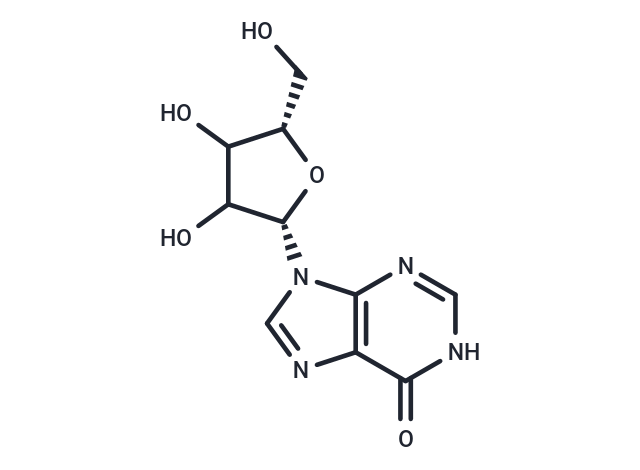Shopping Cart
- Remove All
 Your shopping cart is currently empty
Your shopping cart is currently empty

Inosine (NSC-20262) is a purine nucleoside that has hypoxanthine linked by the N9 nitrogen to the C1 carbon of ribose. It has immunomodulatory, neuroprotective, and analgesic properties.

| Pack Size | Price | Availability | Quantity |
|---|---|---|---|
| 1 g | $29 | In Stock | |
| 1 mL x 10 mM (in DMSO) | $29 | In Stock |
| Description | Inosine (NSC-20262) is a purine nucleoside that has hypoxanthine linked by the N9 nitrogen to the C1 carbon of ribose. It has immunomodulatory, neuroprotective, and analgesic properties. |
| In vitro | Inosine has been shown to stimulate axonal growth in cell culture and promote corticospinal tract axons to sprout collateral branches after stroke, spinal cord injury and TBI in rodent models.[1] Inosine dose-dependently stimulates cAMP production mediated through the A2AR. Inosine dose-dependently induces A2AR-mediated ERK1/2 phosphorylation.[2] |
| In vivo | The reference for Inosine is 1 or 10 mg/kg, i.p. Preventive treatment with inosine inhibits the development and progression of EAE in C57Bl/6 mice. neuroinflammation and demyelinating processes are blocked by inosine treatment. Additionally, inosine consistently inhibits IL-17 levels in peripheral lymphoid tissue, as well as IL-4 levels and A2AR up-regulation in the spinal cord, likely, through an ERK1-independent pathway. [3] inosine acting through adenosine receptors (ARs) exerts a wide range of anti-inflammatory and immunomodulatory effects in vivo. [2] |
| Alias | NSC 20262, INO 495 |
| Molecular Weight | 268.23 |
| Formula | C10H12N4O5 |
| Cas No. | 58-63-9 |
| Smiles | OC[C@@H]1O[C@@H](C(O)C1O)N1C=NC2=C1N=CNC2=O |
| Relative Density. | 2.08 g/cm3 |
| Storage | Powder: -20°C for 3 years | In solvent: -80°C for 1 year | Shipping with blue ice. | |||||||||||||||||||||||||||||||||||
| Solubility Information | Ethanol: < 1 mg/mL (insoluble or slightly soluble) DMSO: 55 mg/mL (205.05 mM), Sonication is recommended. H2O: 43 mg/mL (160.31 mM), Sonication is recommended. | |||||||||||||||||||||||||||||||||||
Solution Preparation Table | ||||||||||||||||||||||||||||||||||||
H2O/DMSO
| ||||||||||||||||||||||||||||||||||||

Copyright © 2015-2025 TargetMol Chemicals Inc. All Rights Reserved.